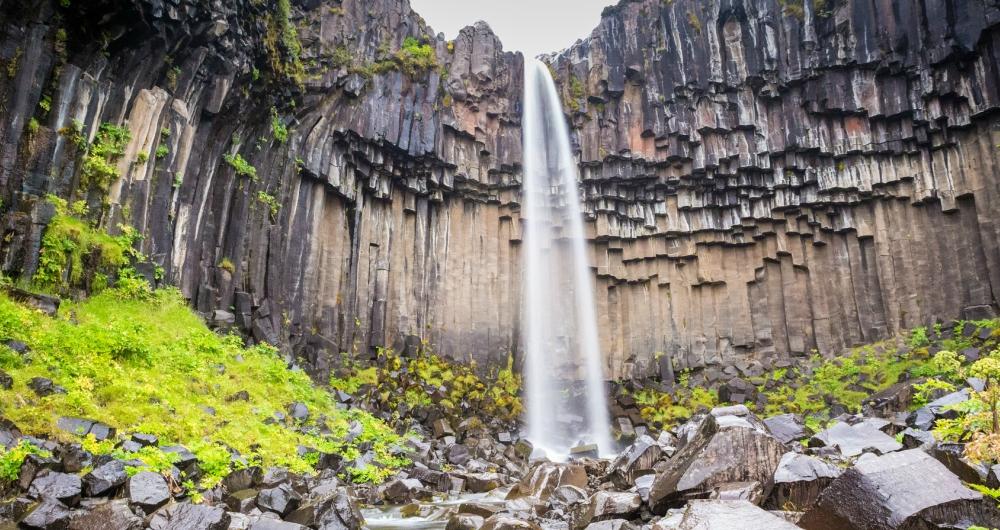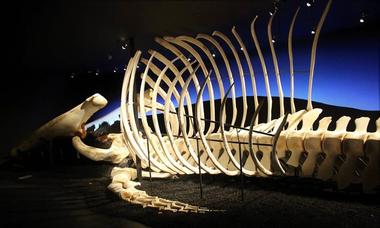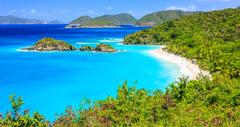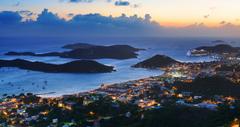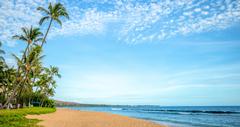Iceland has more than a fair share of natural wonders for visitors to discover, including an enormous glacier, ice caves, volcanoes, geysers, waterfalls, and even shifting tectonic plates. Reykjavik is home to an impressive collection of museums and other cultural attractions. After a long day of sight-seeing you can relax like the locals do by soaking in the hot thermal pools of the spectacular Blue Lagoon.
Blue Lagoon
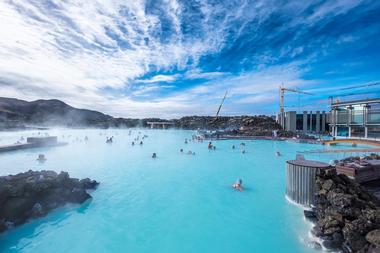
The remarkable Blue Lagoon is essential viewing for all visitors to Iceland as well as offering a relaxing and renewing alternative to sight-seeing. The lagoon came about due to a happy “accident” in the 1970s, when the Svartsengi Geothermal Plant discharged mineral-rich geothermal waters into large area surrounding the plant. The brilliant blue color of the lagoon is caused by the blue-green algae in the water and the lovely warm temperature ensures the whole area is enveloped in a mist of steam. You can join the locals as they relax in the warm waters and cover themselves with the snow-white silica mud, which is believed to be beneficial for a wide variety of skin complaints. After your soak you can shop for unique spa products in the on-site shop.
Blue Lagoon, Nordurljosavegur 9, 240 Grindavik, Iceland, Phone: +35-44-20-88-00
Fjaorargljufur Canyon
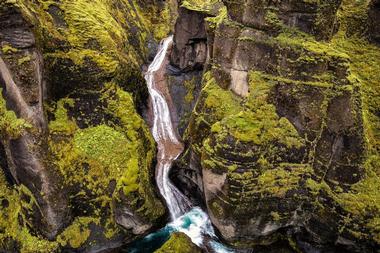
Luckily you don’t have to be able to pronounce the name of this picturesque canyon to enjoy its scenic beauty. The Fjaorargljufur Canyon is a beautiful glacier-carved canyon located in South Iceland, which is believed to have been formed over two million years ago during the last Ice Age.
The canyon is over 300 feet deep and just over one mile long. You have two options for admiring this natural wonder – you could follow the well-worn path along the rim of the canyon for excellent views or be a little more daring and descend the steep grassy trail that leads from the parking area to the canyon floor. Hiking the canyon floor is not strenuous (and is therefore suitable for beginners), but you will need to wade across the river through the freezing glacial waters at several points. Map
Haukadalur Geothermal Field

Imagine a valley of regularly-gushing geysers and bubbling white mud pots and you will have a pretty good idea of what to expect at the Haukadalur Geothermal Field. Although there is no shortage of geysers in Iceland, this particular area is unique in that there is at least one really dependable gusher for visitors to admire. Regardless of what time of day you visit, you only need to wait around 15 minutes for Strokkur (the smaller of two named geysers) to send an impressive fountain of natural geothermal water into the air. Part of the fun is catching the eruption on camera at the precise moment. This popular attraction is located about 60 miles from Reykjavik and is included in several popular tours of the Iceland Golden Circle. Map
If you are interested in wellness adventure, watch this cool video of the Forest Lagoon in Iceland which was discovered by accident. The whole lagoon is built with natural materials and blends into the surrounding nature.
Arbaer Open Air Museum (Arbaejarsafn)
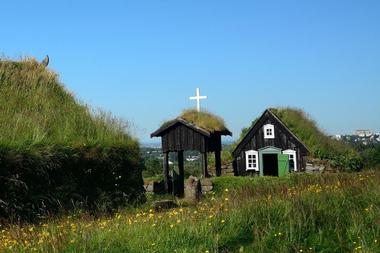
Located approximately two miles from the city center of Reykjavik, the Arbaer Open Air Museum (Arbaejarsafn) is a must see for families and anyone interested in the history of Iceland.
The museum has a collection of around 20 ancient buildings that have been brought to the site from their original locations and set up to resemble a quaint little village complete with a turf-roofed church, farm barns, smithies, and boathouses. The museum hosts a number of interesting events and exhibitions, and there are even some farm animals for the kids to pet. You can get a better insight into the history of Iceland by joining the guided tour and then relax and sip a coffee at the on-site café.
Arbaer Open Air Museum (Arbaejarsafn), Arbaer Open Air Museum, Kistuhyl, 110 Reykjavik, Iceland, Phone: +35-44-11-63-00
Grjotagja
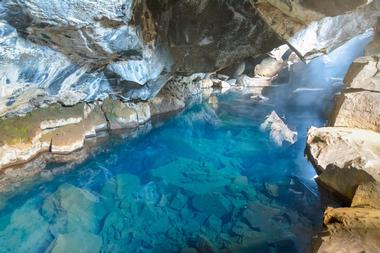
Located near Lake Myvatn in northern Iceland, Grjotagja is another of Iceland’s hidden treasures. If you are a fan of Game of Thrones, you may recognize this lovely volcanic cave, which featured in Season Three of the popular series.
The cave contains a beautiful natural geo-thermal lake that was once a very popular swimming pool for the local people until recent volcanic activity (1975-1984) caused the water in the pool to become far too hot for swimming. Although water temperatures have returned to reasonable levels in recent years, swimming is now banned in the cave, but it is still worth a visit if you are in the area. Map
Hallgrimskirkja
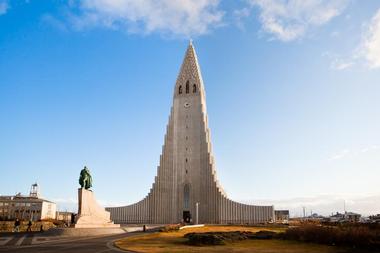
Reykjavik’s most prominent landmark, the Evangelic-Lutheran church of Hallgrimskirkja towers over the city and is one of the most-visited tourist attractions. The modernist architecture of the church is quite unique and includes a stepped façade that pays homage to Iceland’s rugged landscape. You can take an elevator to the top of the imposing 242-foot tower to enjoy sweeping views of the city and surrounds. Inside, décor is restrained, as befits a Lutheran place of worship, and there is a very impressive pipe organ to admire. Try and time your visit for 12 noon, when a meditation service with organ accompaniment takes place. Entrance is free but a small fee applies to entering the tower.
Hallgrimskirkja, Hallgrimstorg 101, Reykjavik, Iceland, Phone: +35-45-10-10-00
Harpa Reykjavik Concert Hall and Conference Center

Harpa Reykjavik Concert Hall and Conference Center is a multi-faceted landmark in central Reykjavik that operates as a social and cultural hub as well as an impressive concert hall that is home to the Iceland Symphony Orchestra, the Icelandic Opera and the Reykjavik Big Band. As the cultural heart of the city, Harpa hosts a full menu of annual events, which include music and art festivals, and it is also used for fashion, design, and many other exhibitions. The best way to appreciate Harpa is to join a guided tour of the facility, which will take you “back stage” to learn about the unique architecture and history of the building.
Harpa Reykjavik Concert Hall and Conference Center, Austurbakki 2, 101 Reykjavik, Iceland, Phone: +3-54-52-85-00
Husavik Whale Museum
Located in the town of Husavik on the north coast of Iceland, the Husavik Whale Museum offers the educational component of the town’s popular whale watching trips that can be enjoyed during the summer months. The small museum aims to educate both locals and visitors on everything there is to know about the world’s largest mammal and its habitat. If you are planning to join a whale-watching excursion, visiting the museum before you set off will add a whole new dimension to your experience. You can also view the enormous whale skeletons on show and learn about the Whale School, which ensures that all local children grow up with thorough background knowledge of the majestic whale.
Husavik Whale Museum, Whale Museum, Hafnarstett 1, 640 Husavik, Iceland, Phone: +35-44-14-28-00
Hvitserkur

Rising from the ocean on the north shore of Iceland, Hvitserkur is a curious basalt sea stack shrouded in local legend. Once a solid volcanic plug, centuries of relentless pounding by the waves of the Atlantic have carved two tunnels through the stone, which is now said to resemble an enormous dragon drinking from the ocean.
You can view the intriguing sea stack from the parking lot on the mainland or take a walk down to the shore – at low tide it is possible to walk out to the monolith to get some great photos. During the summer months the sea stack plays host to a large colony of nesting fulmar and the surrounding area is home to one of Iceland’s largest seal colonies. Map
Kerid Crater Lake

Located in the caldera of a long-extinct volcanic crater, the Kerid Crater Lake is another of Iceland’s unique natural wonders. What makes this particular lake so special are the remarkable colors that surround it; the lake itself is a particularly bright shade of sapphire that Mother Nature has enhanced with the unique red color of the surrounding volcanic rocks and areas of bright green moss.
For a small fee you can walk around the crater rim and even descend into the crater to reach the edge of the lake. Kerid Crater Lake can be easily accessed along the popular Golden Circle route in southern Iceland. Map
Musee de Skogar (Skogar Museum)
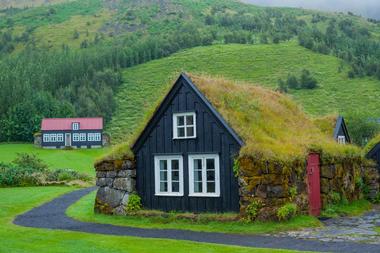
Musee de Skogar (Skogar Museum) complex is located in southern Iceland very near to the famous Skogar Waterfall. The museum offers visitors the chance to learn about the history and culture of Iceland by stepping inside a variety of original Icelandic structures that have been collected from all over the country and reassembled on site. The buildings include a traditional turf farmhouse as well as a schoolhouse, a church, and a traditional cattle barn. Modern additions include a hydroelectric plant to show visitors how the original pioneers harnessed the power of Iceland’s plentiful waters. A recent addition is the Museum of Transportation, which traces transportation advances from ancient to modern times.
Musee de Skogar (Skogar Museum), Skogasafn 1, (Museum Way), Skogar, Iceland, Phone: +35-44-87-88-45
The National Gallery of Iceland
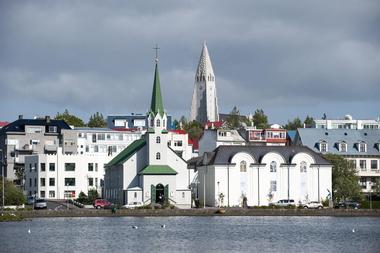
The National Gallery of Iceland is located in Reykjavik and is proud to showcase an impressive collection of fine art. The main emphasis of the gallery’s extensive collections are Icelandic Artists of the 19th and 20th century, but the gallery also boasts an impressive collection of works by internationally known artists such as Edward Munch, Hans Hartung, and Pablo Picasso, to name but a few. The collections are showcased in a series of accessible galleries spread across three floors, and the gallery also holds regular visiting exhibitions by both local and international artists. You can conclude your visit to the gallery with a drink or snack at the restaurant and a visit to the gift shop.
The National Gallery of Iceland, Frikerkjuvegi 7, 101 Reykjavik, Iceland, Phone: +35-45-15-96-00
The National Museum of Iceland
Visiting The National Museum of Iceland is a fun and easy way of learning about the fascinating history and culture of this island nation. The museum’s permanent collection is entitled The Making of a Nation, and it traces the history of the country from the Settlement Age to the present and includes over 2,000 objects and 1,000 photos. As well as the permanent collection the museum features regularly-changing temporary exhibitions and events throughout the year, some of which are displayed in the near-by Culture House, which forms a separate part of the National Museum. After touring the museum you can enjoy a snack at the café before visiting the gift shop.
The National Museum of Iceland, Suourgata 41, 101 Reykjavik, Iceland, Phone: +35-45-30-22-00
Svartifoss
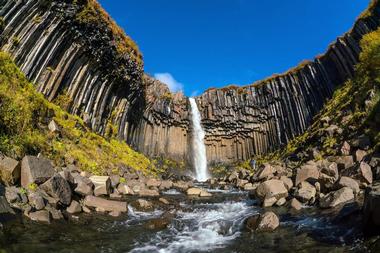
Although the Svartifoss is neither the tallest or largest waterfall in Iceland, it is definitely worth a visit to admire the unique black hexagonal lava columns that form its backdrop. Nestled in the heart of the Skaftafell National Park in southern Iceland, the unusual lava columns were formed over many centuries by slowly cooling lava, which has resulted in a most unusual formation of rocky pillars.
You can reach this peaceful and scenic waterfall quite easily along a well-marked hiking trail in the national park. It is the ideal spot for a picnic, but do not be tempted to try and swim, as the base of the pool is full of sharp rocks. Map
The Arctic Henge
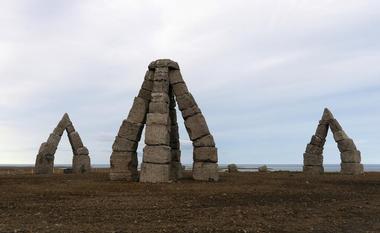
Currently a work in progress, it is believed that on completion, The Arctic Henge will dwarf famous Stonehenge in the U.K. The planned complex will eventually be over 160 feet in diameter and will contain concentric rows of stones and stone monuments aligned with the midnight sun. The pagan complex currently consists of a central balanced tri-column structure that will form the epicenter of the final monument. Still to come are 72 small blocks that represent dwarfs (the outer circle) and four larger stone monuments, which are to be built around the central column. The entire monument is based on the eddic poem Voluspa (Prophecy of the Seeress).
The Arctic Henge, Adalbraut 2, 675 Raufarhofn, Iceland, Phone: +35-44-65-12-33


